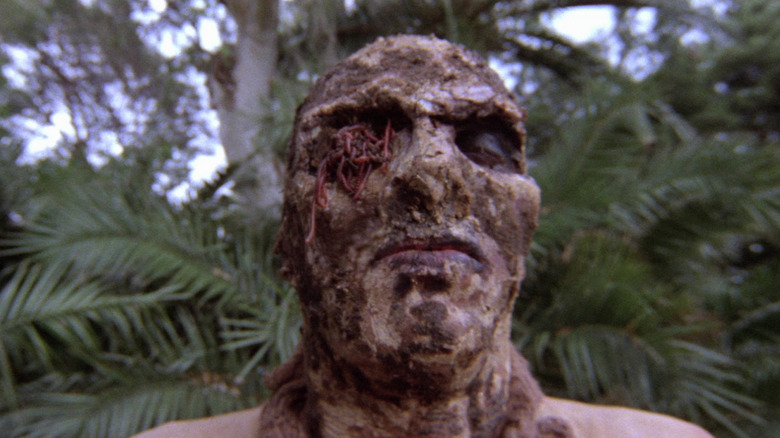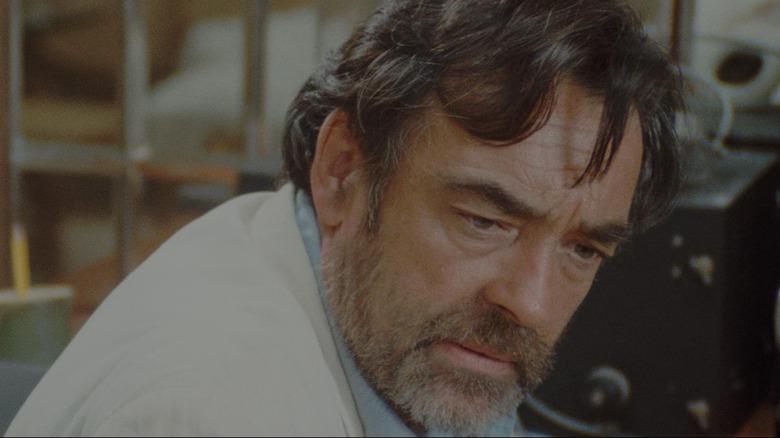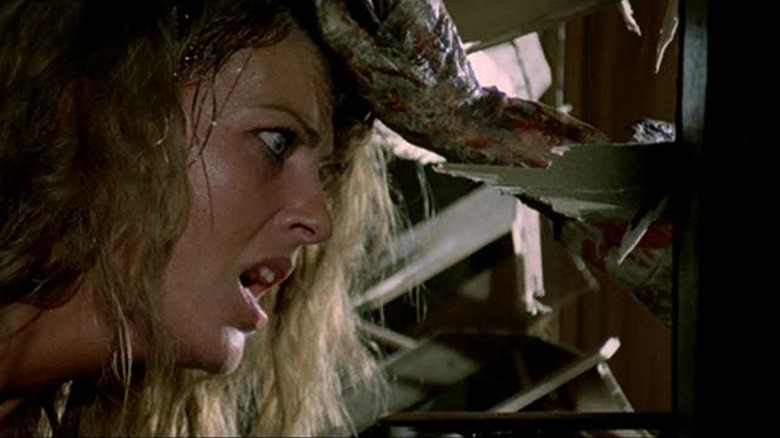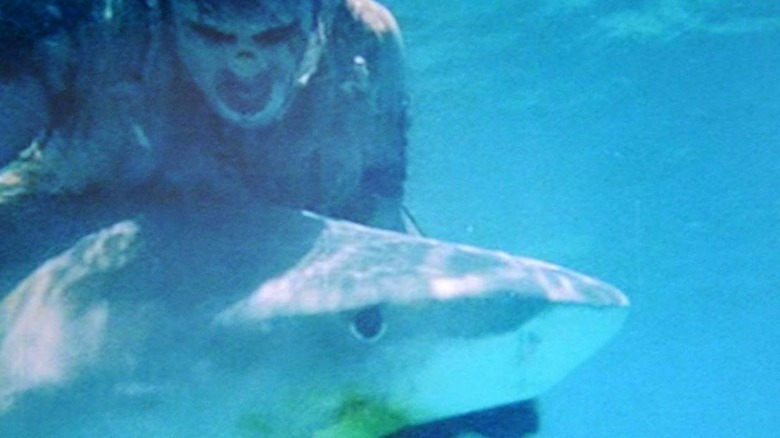The Unofficial Sequel To Dawn Of The Dead You Really Should Watch
The notion of a "zombie apocalypse" has been popular for the past few decades, and the irony is that just such an event has happened within pop culture. After all, zombies are everywhere — books, long-running television shows, board games, video games, action figures, apparel, and, of course, the movies.
Yet this wasn't always the case. In fact, just 40-odd years ago, the zombie was still the near-exclusive purview of the filmmaker who defined the creature with 1968's "Night of the Living Dead," George A. Romero. While a few other, mostly European horror films played with the notion of the dead returning to life and attacking the living (notably 1972's "Tombs of the Blind Dead" and 1974's "Let Sleeping Corpses Lie"), it was Romero who kept the living dead in exclusively modern spaces and adhered to the "rules" of the creature he'd established in "Night."
When Romero's follow-up to "Night," "Dawn of the Dead," was released in Italy in 1978 under the title "Zombi," the Italian film industry took note as it became a box office sensation. Seeing "Zombi's" success, the enterprising (or unscrupulous — take your pick) producer Fabrizio De Angelis took advantage of Italy's loose copyright laws (which allows any film to be advertised as a sequel to another) and decided to put an unofficial sequel into production entitled "Zombi 2." The Lucio Fulci film, while not an actual sequel to "Dawn," would become hugely influential all on its own. With such standout set pieces like the world's grisliest instance of eyeball trauma and a zombie vs. tigershark title fight, "Zombi 2" aka "Zombie" is an entry into the zombie genre that is not just unmissable, but essential.
Zombie digs into the past
Where Romero's "Dead" films were blisteringly modern and immediate, "Zombi 2" looks to the past to hang its narrative on. Screenwriters Dardano Sacchetti and Elisa Briganti fashion the film's story from a mixture of pulp fiction, EC Comics, and "Scooby-Doo"-style mystery, making the movie feel classical and timeless.
Taking a cue from classic zombie films like 1932's "White Zombie" and 1943's "I Walked With a Zombie" (as well as the lore surrounding the creature from traditional voodoo), "Zombi 2" is primarily set on the fictional Caribbean island of Matul, where the shady Dr. David Menard (Richard Johnson) is conducting research into the outbreak of zombified reanimation that's happening on the island. After a rogue abandoned boat from Matul drifts into New York Harbor, the daughter of the boat's owner, Anne (Tisa Farrow), gathers together a journalist (Ian McCulloch), a ship captain (Al Cliver) and the captain's girlfriend (Auretta Gay) to travel to the island and investigate.
The adventure story feel of "Zombi 2" is no accident — according to a 2002 interview with Sachetti, the writer began the script for the film as an homage to the character of Tex Willer, which was "an Italian comic strip in which there's fantastique episodes," including a run where Tex fights off zombies. Thus, "Zombi 2" is a movie which has more in common with classic horror, adventure, and pulp fiction stories than with Romero's films. Except, of course, for the opening and closing scenes set in NYC, which the writer states were added in order to "give the impression that the zombies invading New York are the same [as] those of Romero."
Wood splinter vs. eye, zombie vs. shark: Zombi 2's unforgettable match-ups
Director Lucio Fulci didn't have much experience within the horror genre before making "Zombi 2," but you wouldn't know it given how unforgettably gory and macabre the film is. "Zombi 2" follows Romero's films when it comes to depicting its living dead, of course: shambling, flesh-eating ghouls with sunken faces, bloody wounds and, in one memorable instance, wriggling worms, the fiends dispatched through severe head trauma of some kind. Yet while the film naturally climaxes with a mass of zombies attacking our dwindling group of heroes, it's two earlier scenes that really sets "Zombi 2" apart from its predecessors and earns the movie its own unique place in horror history.
In one, Dr. Menard's wife Paola (Olga Karlatos), is menaced by a zombie at the couple's isolated island home. Attempting to stop the ghoul from shoving open a door into the house, she is apparently successful by mashing the door on the zombie's hand, turning it to a pulp. Not to be deterred, the zombie smashes its other arm through the wooden door, and while Paola tries to bar the door with a dresser, the zombie gets a handful of her hair and pulls her torturously forward toward a loose splinter from the broken wooden door, which her eye is then impaled upon. It's a sequence worthy of both Herschell Gordon Lewis and Alfred Hitchcock all in one swoop, the drawn-out suspense of the latter meeting the in-your-face gore of the former. Being a fiendishly clever exploitation filmmaker, Fulci stages the scene as a riposte to the earlier moments of Paola nude in the shower, punishing the viewer with a different kind of eye-f***ing.
If the eye-gouging scene is Fulci torturing the viewer, the zombie vs. shark scene is the director (and producer Ugo Tucci) offering up pure delicious exploitation cheese. Beginning with a moment featuring Gay's character going diving in the ocean while topless, the woman encounters a nearby tiger shark, only to then be menaced by an underwater zombie! Sure enough, the shark and zombie butt heads, and the scene becomes gloriously outrageous thanks to Ramón Bravo's bravery as a stunt performer (as described in this piece from Little White Lies on the making of the scene) and Fabio Frizzi's electro-pop score.
Zombi 2 cements the creature and the genre's versatility — and popularity
Taken as a whole, "Zombi 2" is a film that transcends its roots as a quickie cash-in rip-off of "Dawn of the Dead." While Romero unequivocally deserves credit for creating and establishing the tenets of the zombie and its subgenre, "Zombi 2" is arguably the movie that proved the creature had far more creative gas in the tank than as a vehicle for social commentary or as a stock horror beastie.
"Zombi 2" utilizes Romero's conception of the creature while proving that the zombie could continue to expand beyond the filmmaker's idea of the character. Just a few years after "Zombi 2" made a splash in Italy and in American grindhouse theaters, Dan O'Bannon made "The Return of the Living Dead," a movie that furthered the zombie mythos by establishing the living dead's preference for eating brains. Seventeen years later, Danny Boyle and Alex Garland's "28 Days Later" reconfigured Romero's apocalyptic scenario for the post-millennium, with the rage-filled "infected" acting like zombies in everything but name. In a way, 2009's "Zombieland" owes a direct debt to Fulci's "Zombi 2," as the horror-comedy puts an emphasis on increasingly wild and grisly zombie kills.
"Zombi 2" not only furthered the mythology of the zombie and perpetuated the zombie subgenre, it also kicked off Fulci's career in horror films, creating a reputation for the director which still holds. Thanks to all of this, the film may be the most accomplished unofficial sequel in history. In any case, it's a movie not to be missed, one that should become part of your zombie diet as soon as possible.



